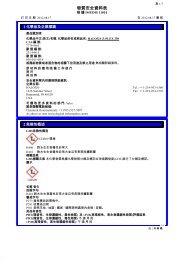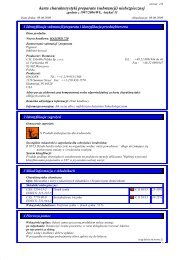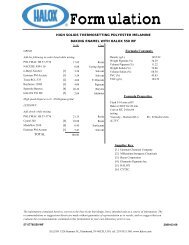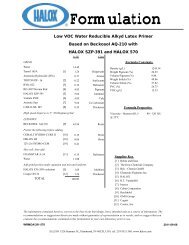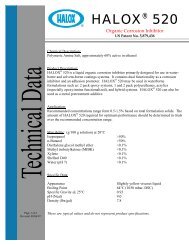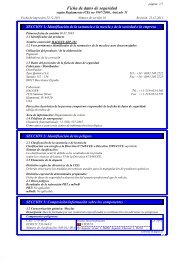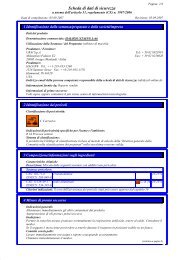Safety Data Sheet - Halox
Safety Data Sheet - Halox
Safety Data Sheet - Halox
You also want an ePaper? Increase the reach of your titles
YUMPU automatically turns print PDFs into web optimized ePapers that Google loves.
DR<strong>Safety</strong> <strong>Data</strong> <strong>Sheet</strong>according to 1907/2006/EC, Article 31Page 2/6Printing date 31.01.2008 Revision: 31.01.2008Trade name: HALOX® 550· After inhalationSupply fresh air. If required, provide artificial respiration. Keep patient warm. Consult doctor.In case of unconsciousness bring patient into stable side position for transport.· After skin contactInstantly wash with water and soap and rinse thoroughly.Seek medical treatment.· After eye contact Rinse opened eye for several minutes under running water. Then consult doctor.· After swallowingRinse out mouth and then drink plenty of water.Seek medical treatment.(Contd. of page 1)5 Fire fighting measures· Suitable extinguishing agentsCarbon dioxide (CO₂), extinguishing powder or water spray/fog. Fight larger fires with water spray/fog oralcohol-resistant foam.· For safety reasons unsuitable extinguishing agents none· Special hazards caused by the material, its products of combustion or flue gases:Can form explosive vapour-air mixtures.Carbon monoxide (CO) and Carbon dioxide (CO₂)Silica fumesAldehydes· Protective equipment: Wear self-contained breathing apparatus.· Additional informationCool endangered containers with water spray jet.Dispose of fire debris and contaminated fire fighting water in accordance with official regulations.6 Accidental release measures· Person-related safety precautions:Ensure adequate ventilation.Wear protective equipment. Keep unprotected persons away.Remove all ignition sources.Use breathing protection against the effects of fumes/dust/aerosol.Do not breathe vapours.· Measures for environmental protection:Do not allow to enter drainage system, surface or ground water.Prevent material from reaching sewage system, holes and cellars.· Measures for cleaning/collecting:Ensure adequate ventilation.Absorb with liquid-binding material (sand, diatomite, acid binders, universal binders, sawdust).Dispose of the material collected according to regulations.7 Handling and storage· Handling· Information for safe handling:Ensure good ventilation/exhaustion at the workplace.Do not inhale vapours/aerosols.Avoid skin and eye contact.Make sure that all applicable workplace limits are observed.· Information about protection against explosions and fires:The product forms flammable fumes when heated.Keep ignition sources away - Do not smoke.(Contd. on page 3)GB
DR<strong>Safety</strong> <strong>Data</strong> <strong>Sheet</strong>according to 1907/2006/EC, Article 31Page 3/6Printing date 31.01.2008 Revision: 31.01.2008Trade name: HALOX® 550· Storage· Requirements to be met by storerooms and containers:Observe all local and national regulations for storage of water polluting products.· Information about storage in one common storage facility:Do not store together with oxidizing and acidic materials.· Further information about storage conditions:Store in cool, dry conditions in well sealed containers.Protect from heat and direct sunlight.Store container in a well ventilated position.(Contd. of page 2)8 Exposure controls and personal protection· Additional information about design of technical systems: No further data; see item 7.· Components with critical values that require monitoring at the workplace:111-76-2 2-ButoxyethanolWEL (Great Britain) Short-term value: 50 ppmLong-term value: 25 ppmSkIOELV (European Union) Short-term value: 246 mg/m³, 50 ppmLong-term value: 98 mg/m³, 20 ppmSkin· Additional information: The lists that were valid during the compilation were used as basis.· Personal protective equipment· General protective and hygienic measuresKeep away from foodstuffs, beverages and food.Do not eat, drink or smoke while working.Instantly remove any contaminated garments.Do not inhale gases / fumes / aerosols.Avoid contact with the eyes and skin.Wash hands during breaks and at the end of the work.· Breathing equipment:If all workplace limits are observed and good ventilation is ensured, no special precautions nessecary.· Protection of hands:Protective glovesTo avoid skin problems reduce the wearing of gloves to the required minimum.Check the permeability prior to each anewed use of the glove.The glove material has to be impermeable and resistant to the product/ the substance/ the preparation.Selection of the glove material on consideration of the penetration times, rates of diffusion and thedegradation.· Material of glovesNeoprene glovesNitrile rubber - NBRButyl rubber - BRThe selection of the suitable gloves does not only depend on the material, but also on further marks of qualityand varies from manufacturer to manufacturer. As the product is a preparation of several substances, theresistance of the glove material can not be calculated in advance and has therefore to be checked prior to theapplication.· Penetration time of glove materialThe exact break through time has to be found out by the manufacturer of the protective gloves and has to beobserved.· Eye protection: Tightly sealed safety glasses· Body protection: Protective work clothingGB(Contd. on page 4)
DR<strong>Safety</strong> <strong>Data</strong> <strong>Sheet</strong>according to 1907/2006/EC, Article 31Page 4/6Printing date 31.01.2008 Revision: 31.01.2008Trade name: HALOX® 550(Contd. of page 3)9 Physical and chemical properties:· General InformationForm:Colour:Smell:liquidclearcharacteristic· Change in conditionMelting point/Melting range: not determinedBoiling point/Boiling range: not determined· Flash point: 61°C· Ignition temperature: 240°C· Self-inflammability: Product is not selfigniting.· Danger of explosion: Product is not explosive. However, formation of explosive air/vapourmixtures is possible.· Critical values for explosion:Lower: 1.1 Vol %Upper: 10.6 Vol %· Density at 20°C 0.992 g/cm³· Solubility in / Miscibility withWater:fully miscible· pH-value at 20°C: 5.0 - 8.0· Additional information Further informations please refer to technical data sheet.10 Stability and reactivity· Thermal decomposition / conditions to be avoided: No decomposition if used according to specifications.· Materials to be avoided:Strong oxidizing agentsStrong acids· Dangerous reactions The product forms flammable fumes when heated.· Dangerous products of decomposition:Carbon monoxide (CO) and Carbon dioxide (CO₂)Silica fumesOrganic acidsKetonesAldehydes11 Toxicological information· Acute toxicity:· LD/LC50 values that are relevant for classification:111-76-2 2-ButoxyethanolOral LD50 1480 mg/kg (rat)Dermal LD50 400 mg/kg (rabbit)· Primary irritant effect:· on the skin: Irritating for the skin· on the eye: Irritant effect· Sensitization: No sensitizing effect known.(Contd. on page 5)GB
DR<strong>Safety</strong> <strong>Data</strong> <strong>Sheet</strong>according to 1907/2006/EC, Article 31Page 5/6Printing date 31.01.2008 Revision: 31.01.2008Trade name: HALOX® 550· Additional toxicological information:Danger by skin resorption.The product shows the following dangers according to the calculation method of the General ECClassification Guidelines for Preparations as issued in the latest version:HarmfulIrritant(Contd. of page 4)12 Ecological information:· General notes: Water hazard class 2 (Self-assessment): hazardous for water13 Disposal considerations· Product:· Recommendation Disposal must be made according to official regulations.· European waste catalogueWaste disposal key numbers from EWC have to be assigned depending on origin and processing.· Uncleaned packagings:· Recommendation: Disposal must be made according to official regulations.· Recommended cleaning agent: Water, if necessary with cleaning agent.14 Transport information· Land transport ADR/RID (cross-border):· ADR/RID Class: -· Maritime transport IMDG/GGVSea:· IMDG/GGVSea Class: -· Air transport ICAO-TI and IATA-DGR:· ICAO/IATA Class: -· Transport/Additional information: Not dangerous according to the above specifications.15 Regulatory information· Designation according to EC guidelines:The product has been classified/labelled in accordance with EC Directives / relevant national laws.· Code letter and hazard designation of product:Xn Harmful· Hazard-determining components of labelling:2-Butoxyethanol· Risk phrases:20/21/22 Harmful by inhalation, in contact with skin and if swallowed.36/38 Irritating to eyes and skin.· <strong>Safety</strong> phrases:23 Do not breathe fumes/aerosol.26 In case of contact with eyes, rinse immediately with plenty of water and seek medical advice.(Contd. on page 6)GB
DR<strong>Safety</strong> <strong>Data</strong> <strong>Sheet</strong>according to 1907/2006/EC, Article 31Page 6/6Printing date 31.01.2008 Revision: 31.01.2008Trade name: HALOX® 55036/37 Wear suitable protective clothing and gloves.· National regulations(Contd. of page 5)· Information about limitation of use: Employment restrictions concerning young persons must be observed.· Decree to be applied in case of technical fault: -· Water hazard class: Water hazard class 2 (Self-assessment): hazardous for water16 Other information:These data are based on our present knowledge. However, they shall not constitute a guarantee for anyspecific product features and shall not establish a legally valid contractual relationship.· Relevant R-phrases:20/21/22 Harmful by inhalation, in contact with skin and if swallowed.36/38 Irritating to eyes and skin.· Department issuing MSDS:C.S.B. GmbH Phone: ++49 - 2151 - 652086-0Oberstraße 10 Fax: ++49 - 2151 - 652086-9D-47829 KrefeldGermanyGB



